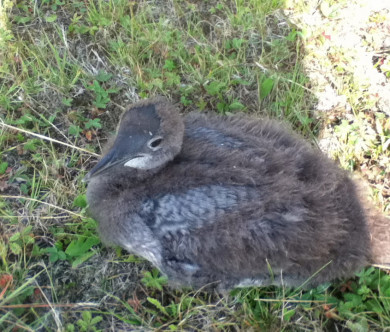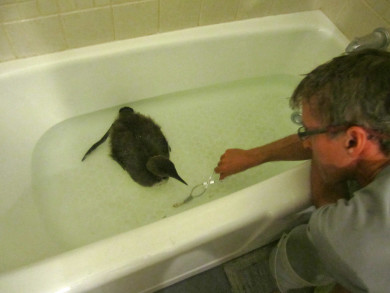By Ali Wagner
Two expressions I often use when birding are: Timing is everything and birding trumps everything. On August 18, a Common Loon chick convinced me that only one of these statements is true as the chick changed the course of my day.
Route 105 in the Northeast Kingdom can be a busy road with 18-wheelers and fast cars. A few miles east of Island Pond in the middle of this drag strip, I saw the distinct shape of a loon. Oh no. But this was not an adult that mistook the glossy road for a body of water. It was a chick, still mostly covered with natal down. HOW did you manage to fly, Little Guy?
The chick offered little resistance when moved to the safety of a grassy area. Things were looking good though, since I had my ten dollar trakPhone charged, and I had service! But August is a busy time of year. I started making phone calls, many phone calls, unable to connect with a live voice! Many desperate messages were left, with details on where a loon and a lady needed rescuing! By now it was 8:30AM and the sun was creeping higher and feeling hotter. I called my friend Eric Hynes for moral support, leaving another message.
I stood close to Little Guy to make shade while we waited together for a miracle. Occasionally the chick would row itself a few feet forward, doing a loon’s version of the butterfly stroke. What was it doing? Where was it going? In the distance I could hear an adult loon calling and the chick would respond. About a half mile south is Spectacle Pond, but between that point and the chick was an obstacle course of open fields, woods, steep embankments, railroad tracks, and crows. It may have been the mounting heat, but to me, the crows resembled a motorcycle gang.
Birding teaches us patience, persistence, and quietness…time passed. Any moment now a car is going to stop to help or my phone is going to ring! I was supposed to meet a friend, Tom, at Moose Bog by now. Thankfully around 9:15, Tom happened to see my car while driving past. We were now a united front. He went to Silvio Conte, reached the hotline at VINS, and was granted permission to move the chick. Kir Talmage at the Birds of Vermont Museum went online to get the phone number of VCE’s loon biologist, Eric Hanson. Although I could not speak to him immediately, I knew Eric would contact me as soon as he could. Next, Eric Hynes called back to coach me in how to carefully wrap a loon in a towel so wings or legs would not get injured.
Now, for me, the concept of “rescuing” or intervening with wildlife is a moral issue. When is it right to get involved? But route 105 and thousands of pounds of moving metal is not nature. Nor is acres of mowed fields that Little Guy would have needed to navigate before the next unnatural hurdle of railroad tracks. Clearly, nature had already been compromised. In my heart, I believed the situation called for some remediation, a sort of canceling out of a few of the human-made obstacles. From me, it felt like a feeble apology for our foolish flaws, and yes, an opportunity to be closer to nature.
Holding the loon in my arms while Tom drove to Spectacle Pond was better than birding. Feeling its strong heart beat through the towel, I worried about the stress of the whole ordeal, but within minutes we were at the water’s edge. I unwrapped the babe, lifted the towel to nudge it forward, and we celebrated when it sprang to new life in the water! We watched it swim toward an adult loon. Then Eric Hanson called.
The Vermont Loon Conservation Project is an amazing program. With just the information I gave him, Eric was able to figure out that the chick most likely came from Beecher Pond, just north and west of Spectacle Pond. When I described the chick to him, he said the chick didn’t fly onto the road, it walked. Over the years, his research has shown that adult loons will sometimes leave the nesting pond and call chicks to follow to another nearby pond. He said that for a few years now, one breeding pair has done this repeatedly. Chicks as young as four or five days old have made journeys across land.
Around 4PM, as I was heading back to the Brighton State Park, I decided to check on the chick from the boat launch. In my scope I saw a pair of adults with one chick. The chick looked a little different. I imagined I was seeing more white around the neck, or could it just appear different because the chick now had wet feathers? But I was reassured all was well by the sight of this threesome in addition to seeing a VCE sticker on a truck in the parking lot. It was Eric, who had followed his great intuition to thoroughly check out the situation. After visiting Beecher Pond, and finding no loons, he knew that the chick didn’t belong on Spectacle Pond. His reliable loon volunteers and data showed the family I was seeing had been here all season. When I asked him if the chick I’d seen in the scope was the one I had rescued, he produced a second chick from his kayak. He had a huge smile on his face, a look of sheer joy and success. After circling the entire pond, he happened to see Little Guy tucked in the reeds. What a lucky bird, to have someone like Eric with such strong conviction to search so thoroughly! And now, Where are your parents was the next mystery to puzzle through.
For the second time that day, the loon took a short ride in a truck. This time it would be released in Island Pond. Eric hoped the parents would be in the corner of this pond that is closest to Beecher Pond. I got the sense that Eric knew this was a long shot, but he needed to give it a try. He knew this part of the pond had no other breeding loons (which would be too close, unsafe, and unlikely for this chick to survive). He released the chick and we watched with great expectations as it slowly made its way toward two adult loons in the distance. But they didn’t connect.
The nearby homeowner, who knew of Eric’s valuable work, had been watching with us. She mentioned a lone loon that hung out in the area. She called it “The Sideline Skulker.” Within ten minutes, the chick made its way back near us and unfortunately close to this adult loon. Instantly, Eric could tell that the chick was going to be in grave trouble … soon. He ran to retrieve his paddle and grab a nearby kayak while I watched the aggressive adult loon circle and peck at the chick. Little Guy’s head lay submerged in the water for only a few seconds that felt more like minutes. Silently I pleaded for Little Guy’s head to pop back up, and it did. Eric was at its side in a flash, and miraculously retrieved the baby in a matter of minutes. He paddled over the chick as it swam underwater hoping to nab the bird as it surfaced. The chick came up under his kayak, and somehow Eric reached deep into the water and grabbed a foot. Little Guy appeared to be unhurt by The Sideline Skulker.
The home owner’s son asked his mom, “Is that your boat?”
“Yes,” she said with a hint of pride in her voice.
“I’ve never seen it move that fast before.”
Eric knew if the chick had any chance of survival without the parents around, it would need to go to Kappy Sprenger, a rehabber in Maine with pools for waterbirds. Eric took it home with him for the night, fed it some minnows, and then made the three-hour drive in the morning to Bridgeton, Maine. After a few days with Kappy, she noticed the feathers were not keeping it waterproofed, so she transferred the loon to Avian Haven, another bird rehab group, for more intensive examination and extra care. They plan on keeping the loon for about a month when it will be ready to take on the world on its own. Good luck, Little Guy!
Ali Wagner is a birder, citizen scientist and educator who lives in Huntington, Vermont.
Comments (10)
Pingbacks (1)
-
[…] This post ©2015 by A. Wagner and used by permission. It also appears in a slightly different form, at the Vermont Center for Ecostudies blog. […]



Great story, all around! Kudos to all who helped.
Thank you to everyone for the diligent and conscientious compassion shown to this little baby….. if only all humans had this level of concern, compassion and daily regard for our wildlife!
Thanks so much to all involved in saving this baby, especially Ali and Eric. Eric is such a savior for loons, and this is a great example of what he’ll do to help save one. Avian Haven is a terrific rescue and rehab center; Little Guy couldn’t be in better hands. Hopefully, they’ll post an update for him on their FB page. Good luck, little one!
Ali,
For all you do right and all you write, I thank you.
I am SO impressed!
Thank you Ali for sharing this great story. It had me on the edge of my nest, but so relieved that Little Guy is now safe, thanks to folks like you and Eric.
Wow! What an amazing story. Thank you for taking care of the loon chick.
Thank you for this beautifully told story about how precious life is and how everyone deserves a chance. Thank you all for being so kind and showing such humanity to help someone. The world needs more people like you.
Great story. Hope to hear more re ‘Little Guy.’ It’s wonderful to have Eric H. assisting us with our loon adventures. Keep up the good work!
Avian Haven , you can be assured, shall take only the finest care of Little Guy. I truly feel privileged to volunteer there as an ‘ambulance driver/transporter’ and Diane and Marc and the staff and volunteers are totally devoted to the little guys of the avian world in Maine and New England. I’m so glad he’s there…we love loons whether from Maine or Vermont!!